clutch FIAT DOBLO COMBI 2012 Owner handbook (in English)
[x] Cancel search | Manufacturer: FIAT, Model Year: 2012, Model line: DOBLO COMBI, Model: FIAT DOBLO COMBI 2012Pages: 283, PDF Size: 6.31 MB
Page 189 of 283
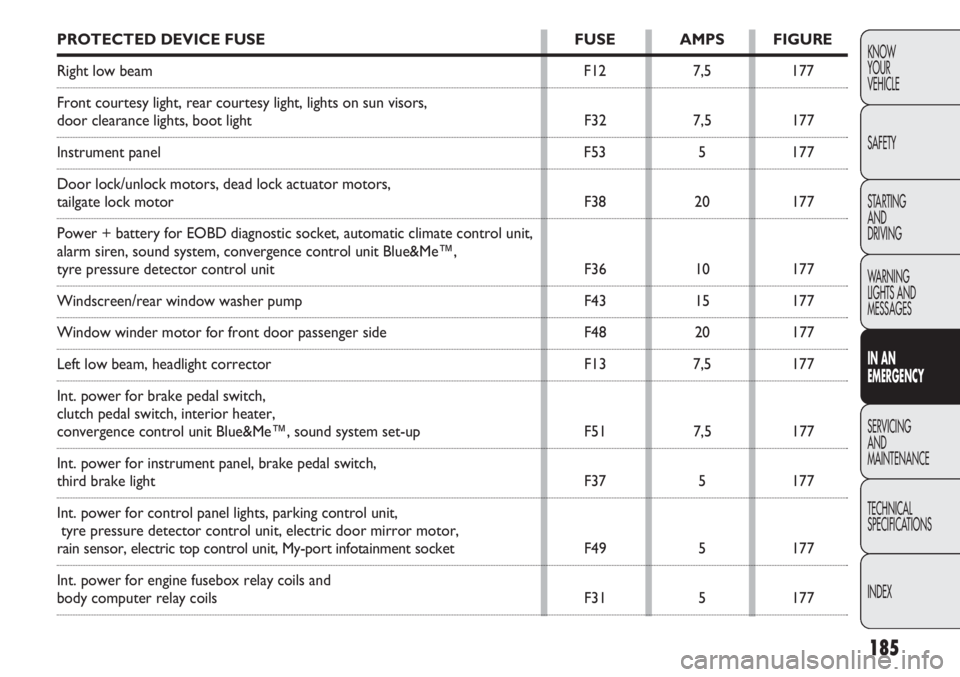
185
KNOW
YOUR
VEHICLE
SAFETY
STARTING
AND
DRIVING
WARNING
LIGHTS AND
MESSAGES
IN AN
EMERGENCY
SERVICING
AND
MAINTENANCE
TECHNICAL
SPECIFICATIONS
INDEXPROTECTED DEVICE FUSE FUSE AMPS FIGURE
Right low beam F127,5177
Front courtesy light, rear courtesy light, lights on sun visors,
door clearance lights, boot light F327,5177
Instrument panel F535177
Door lock/unlock motors, dead lock actuator motors,
tailgate lock motor F3820177
Power + battery for EOBD diagnostic socket, automatic climate control un\
it,
alarm siren, sound system, convergence control unit Blue&Me™,
tyre pressure detector control unit F3610177
Windscreen/rear window washer pump F4315177
Window winder motor for front door passenger side F4820177
Left low beam, headlight corrector F137,5177
Int. power for brake pedal switch,
clutch pedal switch, interior heater,
convergence control unit Blue&Me™, sound system set-up F517,5177
Int. power for instrument panel, brake pedal switch,
third brake light F375177
Int. power for control panel lights, parking control unit, tyre pressure detector control unit, electric door mirror motor,
rain sensor, electric top control unit, My-port infotainment socket F495177
Int. power for engine fusebox relay coils and
body computer relay coils F315177
Page 197 of 283

193
KNOW
YOUR
VEHICLE
SAFETY
STARTING
AND
DRIVING
WARNING
LIGHTS AND
MESSAGES
IN AN
EMERGENCY
SERVIC
ING
AND
MAINTENANCE
TECHNICAL
SPECIFICA TIONS
INDEX
●●
●●●●●●
●
●
●●●●●●
●●●●●●
●●●●●●
●●●●●●
●●●●●● ●●●
●●●●●●
Thousands of kilometres 30 60 90 120 150 180
Months 24 48 72 96 120 144
Inspect the conditions of toothed timing drive belt
Replace spark plugs (▲)
Replace accessory drive belt(s)
Replace toothed timing belt (*)
Replace air filter cartridge
Check and, if necessary, top up fluid levels (brakes/hydraulic
clutch, windscreen washer, battery, engine coolant, etc.)
Check engine management system operation
(through diagnostic socket)
Check cleanliness of sliding side door lower guides
(or every 6 months)
Change engine oil and replace oil filter (**)
Change brake fluid (or every 24 months)
Replace pollen filter (or every 24 months)
(*) Regardless of distance covered, the timing belt must be replaced every f\
our years in the case of particularly demanding use (cold cli-
mate, city traffic, long idling) or at least every five years in all ot\
her cases.
(**) If the vehicle annual mileage is less than 10,000 km, the engine oil and\
filter must be replaced every 12 months.
(
▲) For 1.4 Turbo Petrol versions, in order to guarantee correct operatio\
n and prevent serious damage to the engine, it is essential to
observe the following: - only use spark plugs specifically certified for these engines; all spa\
rk plugs should be of the same type and brand (see the “Engine”
paragraph in the "Technical Specifications" chapter);
- strictly comply with the replacement interval recommended for the plug\
s in the Scheduled Servicing Plan;
- it is advisable to contact a Fiat Dealership for plug replacement.
Page 198 of 283
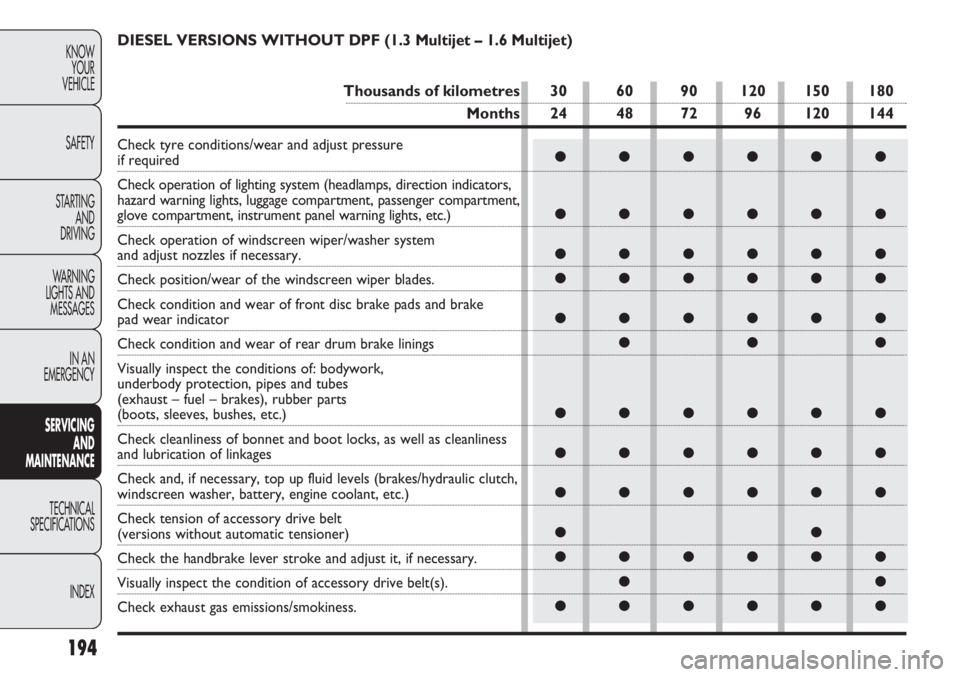
194
KNOWYOUR
VEHICLE
SAFETY
STARTING AND
DRIVING
WARNING
LIGHTS AND MESSAGES
IN AN
EMERGENCY
SERV IC
ING
AND
MAINTENANCE
TECHNICAL
SPECIFICA TIONS
INDEX
●●●●●●
●●●●●●
●●●●●●
●●●●●●
●●●●●● ●●●
●●●●●●
●●●●●●
●●●●●●
●●
●●●●●● ●●
●●●●●●
DIESEL VERSIONS WITHOUT DPF (1.3 Multijet – 1.6 Multijet)
Thousands of kilometres 30 60 90 120 150 180
Months 24 48 72 96 120 144
Check tyre conditions/wear and adjust pressure if required
Check operation of lighting system (headlamps, direction indicators,
hazard warning lights, luggage compartment, passenger compartment,
glove compartment, instrument panel warning lights, etc.)
Check operation of windscreen wiper/washer system
and adjust nozzles if necessary.
Check position/wear of the windscreen wiper blades.
Check condition and wear of front disc brake pads and brake
pad wear indicator
Check condition and wear of rear drum brake linings
Visually inspect the conditions of: bodywork,
underbody protection, pipes and tubes
(exhaust – fuel – brakes), rubber parts
(boots, sleeves, bushes, etc.)
Check cleanliness of bonnet and boot locks, as well as cleanliness
and lubrication of linkages
Check and, if necessary, top up fluid levels (brakes/hydraulic clutch, \
windscreen washer, battery, engine coolant, etc.)
Check tension of accessory drive belt
(versions without automatic tensioner)
Check the handbrake lever stroke and adjust it, if necessary.
Visually inspect the condition of accessory drive belt(s).
Check exhaust gas emissions/smokiness.
Page 200 of 283

196
KNOWYOUR
VEHICLE
SAFETY
STARTING AND
DRIVING
WARNING
LIGHTS AND MESSAGES
IN AN
EMERGENCY
SERV IC
ING
AND
MAINTENANCE
TECHNICAL
SPECIFICA TIONS
INDEX
● ●●●●
● ●●●●
● ●●●●
● ●●●●
● ●●●● ●●
● ●●●●
● ●●●●
● ●●●●
●●
● ●●●● ●●
● ●●●●
DIESEL VERSIONS WITH DPF (1.3 Multijet – 1.6 Multijet – 2.0 Multijet)
Thousands of kilometres 35 70 105 140 175
Months 24 48 72 96 120
Check tyre conditions/wear and adjust pressure if required
Check lighting system operation
(headlights, direction indicators, hazard lights, boot, passenger compa\
rtment,
glove box, instrument panel warning lights, etc.)
Check operation of windscreen wiper/washer system
and adjust nozzles if necessary
Check position/wear of the windscreen wiper blades.
Check condition and wear of front disc brake pads and brake pad wear ind\
icator
Check condition and wear of rear drum brake linings
Visually inspect the conditions of: bodywork,
underbody protection, pipes and tubes
(exhaust – fuel – brakes), rubber parts
(boots, sleeves, bushes, etc.)
Check cleanliness of bonnet and boot locks, as well as cleanliness and
lubrication of linkages
Check and, if necessary, top up fluid levels (brakes/hydraulic clutch, \
windscreen washer, battery, engine coolant, etc.)
Check tension of accessory drive belt
(versions without automatic tensioner)
Check the handbrake lever stroke and adjust it, if necessary.
Visually inspect the condition of accessory drive belt(s).
Check exhaust gas emissions/smokiness.
Page 228 of 283
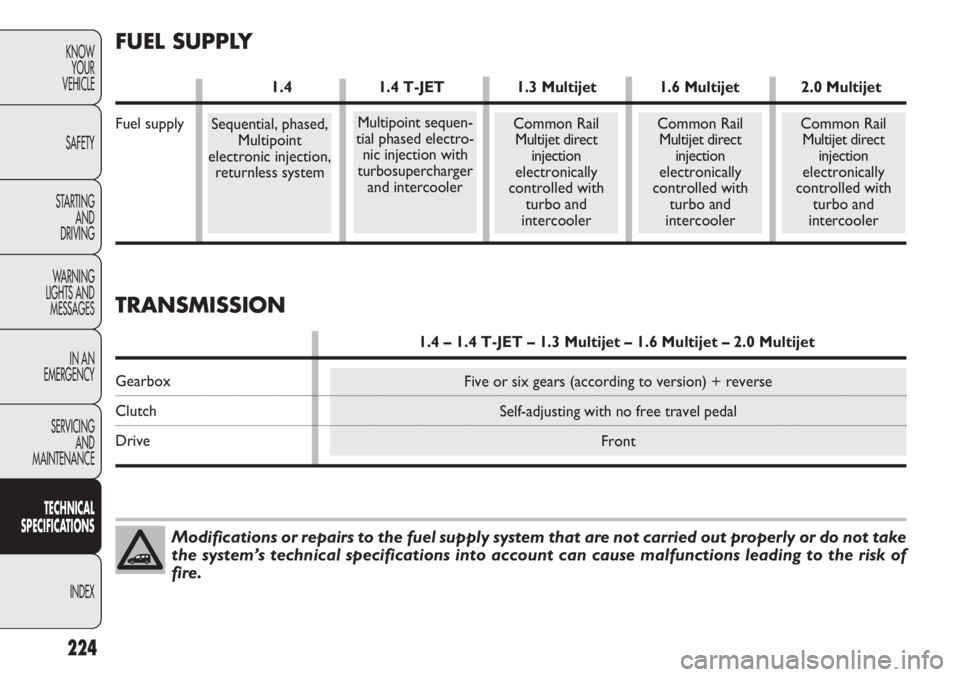
224
KNOWYOUR
VEHICLE
SAFETY
STARTING AND
DRIVING
WARNING
LIGHTS AND MESSAGES
IN AN
EMERGENCY
SERVICING AND
MAINTENANCE
TECHNICAL
SPECIFICAT IO
NS
INDEX
Modifications or repairs to the fuel supply system that are not carried \
out properly or do not take
the system’s technical specifications into account can cause malfunct\
ions leading to the risk of
fire.
Sequential, phased, Multipoint
electronic injection, returnless systemCommon Rail Multijet direct injection
electronically
controlled with turbo and
intercoolerCommon Rail Multijet direct injection
electronically
controlled with turbo and
intercoolerCommon Rail Multijet direct injection
electronically
controlled with turbo and
intercooler
Five or six gears (according to version) + reverse
Self-adjusting with no free travel pedal Front
TRANSMISSION
1.4 – 1.4 T-JET – 1.3 Multijet – 1.6 Multijet – 2.0 Multijet
Gearbox
Clutch
Drive
Multipoint sequen-
tial phased electro- nic injection with
turbosupercharger and intercooler
FUEL SUPPLY
1.4 1.4 T-JET 1.3 Multijet 1.6 Multijet 2.0 Multijet
Fuel supply
Page 252 of 283
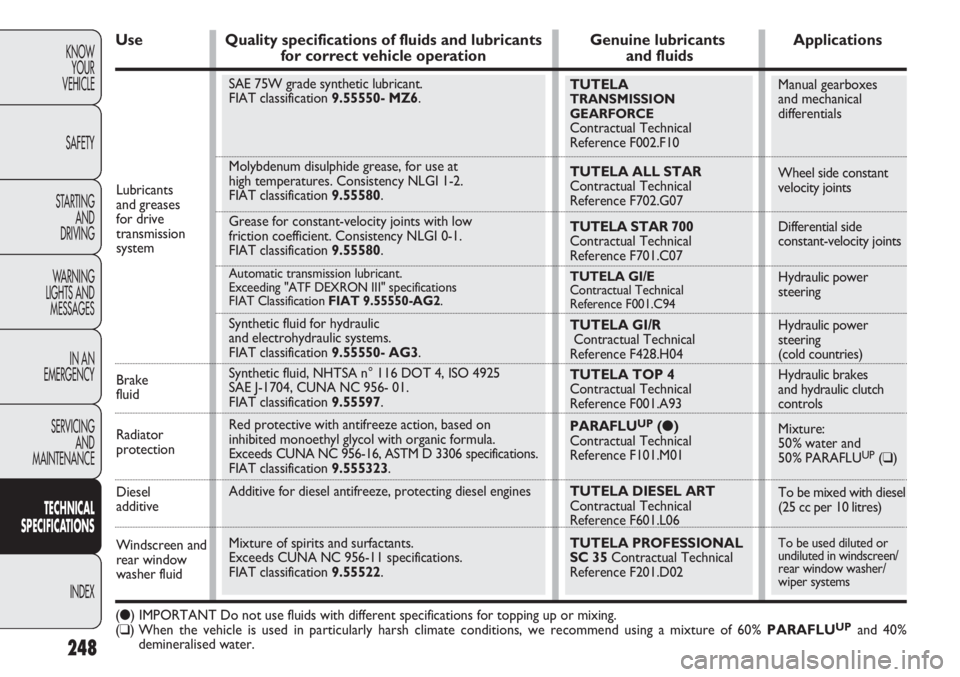
Manual gearboxes
and mechanical
differentials
Wheel side constant
velocity joints
Differential side
constant-velocity joints
Hydraulic power
steering
Hydraulic power
steering
(cold countries)
Hydraulic brakes
and hydraulic clutch
controls
Mixture:
50% water and
50% PARAFLU
UP(❑ )
To be mixed with diesel
(25 cc per 10 litres)
To be used diluted or
undiluted in windscreen/
rear window washer/
wiper systems
TUTELA TRANSMISSION
GEARFORCE
Contractual Technical
Reference F002.F10
TUTELA ALL STAR
Contractual Technical
Reference F702.G07
TUTELA STAR 700
Contractual Technical
Reference F701.C07
TUTELA GI/E
Contractual Technical
Reference F001.C94
TUTELA GI/R Contractual Technical
Reference F428.H04
TUTELA TOP 4
Contractual Technical
Reference F001.A93
PARAFLU
UP(●)
Contractual Technical
Reference F101.M01
TUTELA DIESEL ART
Contractual Technical
Reference F601.L06
TUTELA PROFESSIONAL
SC 35 Contractual Technical
Reference F201.D02
SAE 75W grade synthetic lubricant.
FIAT classification 9.55550- MZ6.
Molybdenum disulphide grease, for use at
high temperatures. Consistency NLGI 1-2.
FIAT classification 9.55580.
Grease for constant-velocity joints with low
friction coefficient. Consistency NLGI 0-1.
FIAT classification 9.55580.
Automatic transmission lubricant.
Exceeding "ATF DEXRON III" specifications
FIAT Classification FIAT 9.55550-AG2.
Synthetic fluid for hydraulic
and electrohydraulic systems.
FIAT classification 9.55550- AG3.
Synthetic fluid, NHTSA n° 116 DOT 4, ISO 4925
SAE J-1704, CUNA NC 956- 01.
FIAT classification 9.55597.
Red protective with antifreeze action, based on
inhibited monoethyl glycol with organic formula.
Exceeds CUNA NC 956-16, ASTM D 3306 specifications.
FIAT classification 9.555323.
Additive for diesel antifreeze, protecting diesel engines
Mixture of spirits and surfactants.
Exceeds CUNA NC 956-11 specifications.
FIAT classification 9.55522.
248
KNOW
YOUR
VEHICLE
SAFETY
STARTING AND
DRIVING
WARNING
LIGHTS AND MESSAGES
IN AN
EMERGENCY
SERVICING AND
MAINTENANCE
TECHNICAL
SPECIFICAT IO
NS
INDEX
Lubricants
and greases
for drive
transmission
system
Brake
fluid
Radiator
protection
Diesel
additive
Windscreen and
rear window
washer fluid
Use Quality specifications of fluids and lubricants Genuine lubricants Applications for correct vehicle operation and fluids
(●) IMPORTANT Do not use fluids with different specifications for topping\
up or mixing.
(❑) When the vehicle is used in particularly harsh climate conditions, we re\
commend using a mixture of 60% PARAFLUUPand 40%
demineralised water.
Page 254 of 283
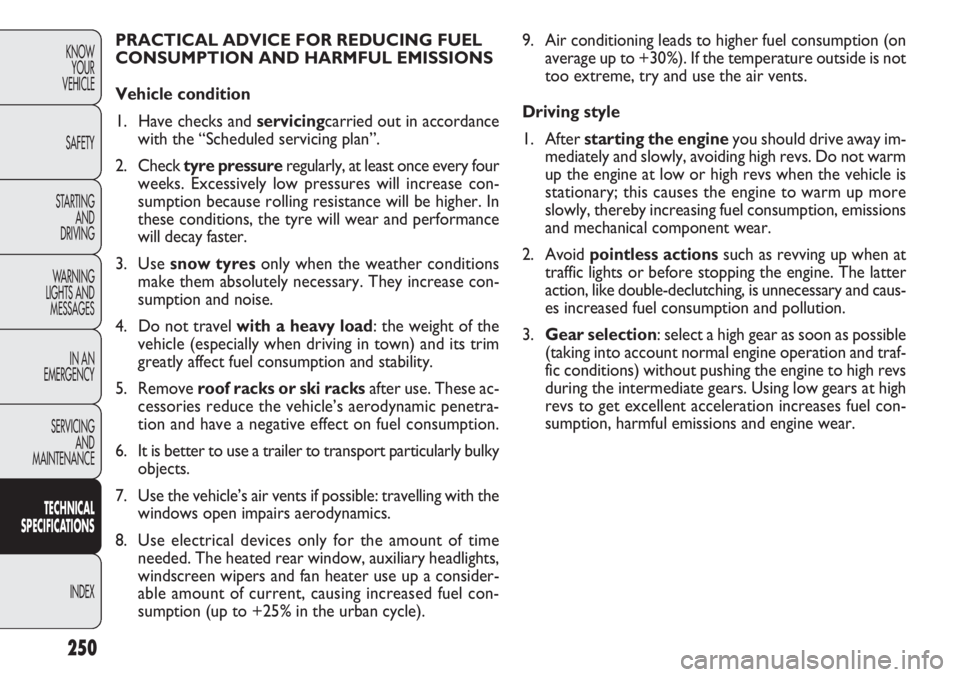
250
KNOWYOUR
VEHICLE
SAFETY
STARTING AND
DRIVING
WARNING
LIGHTS AND MESSAGES
IN AN
EMERGENCY
SERVICING AND
MAINTENANCE
TECHNICAL
SPECIFICAT IO
NS
INDEX
9. Air conditioning leads to higher fuel consumption (on average up to +30%). If the temperature outside is not
too extreme, try and use the air vents.
Driving style
1. After starting the engine you should drive away im-
mediately and slowly, avoiding high revs. Do not warm
up the engine at low or high revs when the vehicle is
stationary; this causes the engine to warm up more
slowly, thereby increasing fuel consumption, emissions
and mechanical component wear.
2. Avoid pointless actions such as revving up when at
traffic lights or before stopping the engine. The latter
action, like double-declutching, is unnecessary and caus-
es increased fuel consumption and pollution.
3. Gear selection: select a high gear as soon as possible
(taking into account normal engine operation and traf-
fic conditions) without pushing the engine to high revs
during the intermediate gears. Using low gears at high
revs to get excellent acceleration increases fuel con-
sumption, harmful emissions and engine wear.
PRACTICAL ADVICE FOR REDUCING FUEL
CONSUMPTION AND HARMFUL EMISSIONS
Vehicle condition
1. Have checks and
servicingcarried out in accordance
with the “Scheduled servicing plan”.
2. Check tyre pressure regularly, at least once every four
weeks. Excessively low pressures will increase con-
sumption because rolling resistance will be higher. In
these conditions, the tyre will wear and performance
will decay faster.
3. Use snow tyres only when the weather conditions
make them absolutely necessary. They increase con-
sumption and noise.
4. Do not travel with a heavy load: the weight of the
vehicle (especially when driving in town) and its trim
greatly affect fuel consumption and stability.
5. Remove roof racks or ski racks after use. These ac-
cessories reduce the vehicle’s aerodynamic penetra-
tion and have a negative effect on fuel consumption.
6. It is better to use a trailer to transport particularly bulky objects.
7. Use the vehicle’s air vents if possible: travelling with the windows open impairs aerodynamics.
8. Use electrical devices only for the amount of time needed. The heated rear window, auxiliary headlights,
windscreen wipers and fan heater use up a consider-
able amount of current, causing increased fuel con-
sumption (up to +25% in the urban cycle).
Page 273 of 283
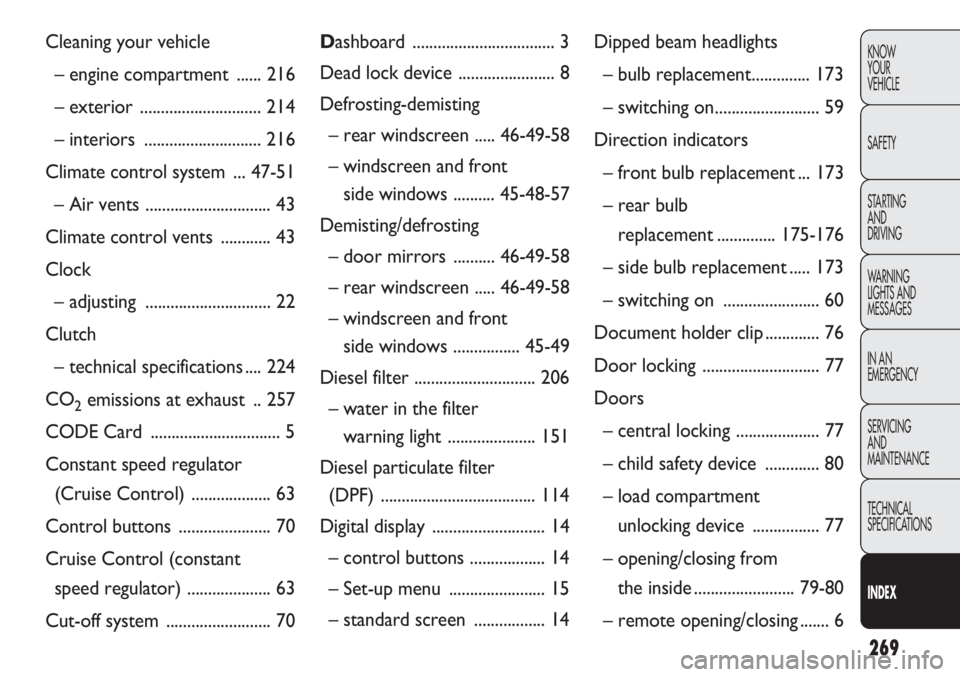
269
KNOW
YOUR
VEHICLE
SAFETY
STARTING
AND
DRIVING
WARNING
LIGHTS AND
MESSAGES
IN AN
EMERGENCY
SERVICING
AND
MAINTENANCE
TECHNICAL
SPECIFICATIONS
INDEXDashboard .................................. 3
Dead lock device ....................... 8
Defrosting-demisting – rear windscreen ..... 46-49-58
– windscreen and front side windows .......... 45-48-57
Demisting/defrosting – door mirro rs ..........46-49-58
– rear windscreen ..... 46-49-58
– windscreen and front side windows ................ 45-49
Diesel filter ............................. 206
– water in the filter warning light ..................... 151
Diesel particulate filter (DPF) ..................................... 114
Digital di splay ........................... 14
– control buttons .................. 14
– Set-up menu ....................... 15
– standard screen ................. 14Dipped beam headlights
– bulb replace ment.............. 173
– switching on......................... 59
Direction indicators – front bulb replacement ... 173
– rear bulb replacement ..............175-176
– side bulb replacement ..... 173
– switching on ....................... 60
Document holder clip ............. 76
Door lock ing ............................ 77
Doors – central locking .................... 77
– child safety device ............. 80
– load compartment unlocking device ................ 77
– opening/closing from the inside ........................ 79-80
– remote opening/closing ....... 6
Cleaning your vehicle
– engine compartment ...... 216
– exterior ............................. 214
– interio rs ............................ 216
Climate control system ... 47-51 – Air vents .............................. 43
Climate control vents ............ 43
Clock – adjusting .............................. 22
Clutch – technical specifications .... 224
CO
2emissions at exhaust .. 257
CODE Card ............................... 5
Constant speed regulator (Cruise Control) ................... 63
Control buttons ...................... 70
Cruise Control (constant speed regulator) .................... 63
Cut-off system ......................... 70